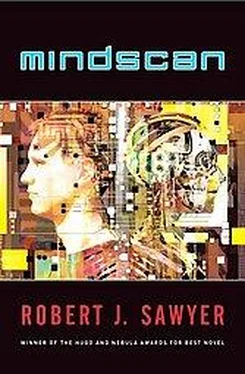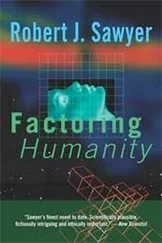“Jake,” I said, taking it. The skin on her hand was loose and liver-spotted, and her knuckles were swollen. I squeezed very gently.
“Where are you from, Jake?”
“Here. Toronto. You?”
“Detroit.”
I nodded. Many of tonight’s potential customers were probably Americans. Immortex had found a much more congenial legal climate for its services in increasingly liberal Canada than in ever-more-conservative America. When I’d been a kid, college students used to come over to Ontario from Michigan and New York because the drinking age was lower here and the strippers could go further. Now, people from those two states crossed the border for legal pot, legal hookers, legal abortions, same-sex marriages, physician-assisted suicide, and other things the religious right frowned upon.
“It’s funny,” said Karen, glancing at the aged crowd. “When I was ten, I once said to my grandmother, ‘Who the heck wants to be ninety?’ And she looked me right in the eye and said, ‘Anyone who is eighty-nine.’” Karen shook her head. “How right she was.”
I smiled wanly.
“Ladies and gentlemen,” called a male voice, just then. “Would you all please take seats?”
Doubtless no one here was hard of hearing; implants easily rectified that sign of aging, too. There were rows of folding chairs at the back of the ballroom, facing a podium. “Shall we?” said Karen. Something about her was charming—the Southern accent, maybe (Detroit certainly wasn’t where she’d grown up)—and there were, of course, the connotations that went with being in a ballroom. I found myself offering my arm, and Karen took it. We walked over slowly—I let her set the pace—and found a pair of seats near the back at one side, an A. Y. Jackson landscape hanging under glass on the wall next to us.
“Thank you,” said the same man who’d spoken before. He was standing at the dark wooden podium. There was no light directly on him; just a little illumination spilling up from a reading lamp attached to the lectern. A gangling Asian of perhaps thirty-five, his black hair was combed straight back above a forehead that would have done Professor Moriarty proud. A surprisingly large, old-fashioned microphone covered his mouth. “My name is John Sugiyama,” he said, “and I’m a vice-president at Immortex. Thank you all for coming tonight. I hope you’ve enjoyed the hospitality so far.”
He looked out at the crowd. Karen, I noticed, was one of those who murmured appreciatively, which seemed to be what Sugiyama wanted. “Good, good,” he said.
“In everything we do, we strive for absolute customer satisfaction. After all, as we like to say, ‘Once an Immortex client, always an Immortex client.’ ” He smiled broadly, and again waited for appreciative chuckles before going on. “Now, I’m sure you’ve all got questions, so let’s get started. I know what we’re selling costs a lot of money—”
Somebody near me muttered, “Damn right,” but if Sugiyama heard, he gave no sign. He continued: “But we won’t ask you for a cent until you’re satisfied that what we’re offering is right for you.” He let his gaze wander over the crowd, smiling reassuringly and making lots of eye contact. He looked directly at Karen but skipped over me; presumably he felt I couldn’t possibly be a potential customer, and so wasn’t worth wasting his charm on.
“Most of you,” Sugiyama said, “have had MRIs. Our patented and exclusive Mindscan process is nothing more daunting than that, although our resolution is much finer. It gives us a complete, perfect map of the structure of your brain: every neuron, every dendrite, every synaptic cleft, every interconnection. It also notes neurotransmitter levels at each synapse. There is no part of what makes you you that we fail to record.”
That much was certainly true. Back in 1990, a philanthropist named Hugh Loebner promised to award a solid gold medal—not just gold-plated like those cheap Olympic ones—plus $100,000 in cash to the first team to build a machine that passed the Turing Test, that old chestnut that said a computer should be declared truly intelligent if its responses to questions were indistinguishable from those of a human being. Loebner had expected it would be only a few years before he’d have to cough up—but that’s not how things turned out. It wasn’t until three years ago that the prize had been awarded.
I’d watched the whole thing on TV: a panel of five inquisitors—a priest, a philosopher, a cognitive scientist, a woman who ran a small business, and a stand-up comic—were presented with two entities behind black curtains. The questioners were allowed to ask both entities anything at all: moral posers, general-knowledge trivia, even things about romance and child-rearing; in addition, the comic did his best to crack the entities up, and to quiz them about why certain jokes were or weren’t funny. Not only that, but the two entities engaged in a dialogue between themselves, asking each other questions while the little jury looked on. At the end, the jurors voted, and they unanimously agreed they could not tell which curtain hid the real human being and which hid the machine.
After the commercial break, the curtains were raised. On the left was a fiftyish, balding, bearded black man named Sampson Wainwright. And on the right was a very simple, boxy robot. The group collected their hundred grand—paltry from a monetary point of view now, but still hugely symbolic—and their gold medal. Their winning entity, they revealed, had been an exact scan of Sampson Wainwright’s mind, and it had indeed, as the whole world could plainly see, thought thoughts indistinguishable in every way from those produced by the original. Three weeks later, the same group made an IPO for their little company called Immortex; overnight, they were billionaires.
Sugiyama continued his sales pitch. “Of course,” he said, “we can’t put the digital copy back into the original biological brain—but we can transfer it into an artificial brain, which is precisely what our process does. Our artificial brains congeal out of quantum fog, forming a nanogel that precisely duplicates the structure of the biological original. The new version is you —your mind instantiated in an artificial brain made out of durable synthetics. It won’t wear out. It won’t suffer strokes or aneurysms. It won’t develop dementia or senility. And…” He paused, making sure he had everyone’s attention. “It won’t die. The new you will live potentially forever.”
Even though everyone knew that’s what was for sale here, there were still sounds of astonishment —“forever” had such weight when spoken aloud. For my part, I didn’t care about immortality—I rather suspected I’d get bored by the time I reached, well, Karen’s age. But I’d been walking on eggshells for twenty-seven years, afraid that the blood vessels in my brain would rupture. Dying wouldn’t be that bad, but the notion of ending up a vegetable like my father was terrifying to me. Fortunately, Immortex’s artificial brains were electrically powered; they didn’t require chemical nutrients, and weren’t serviced by blood vessels. I rather doubted this was the cure Dr. Thanh had had in mind, but it would do in a pinch.
“Of course,” continued Sugiyama, “the artificial brain needs to be housed inside a body.”
I glanced at Karen, wondering if she’d read up on that aspect before coming here.
Apparently, the scientists who had first made these artificial brains hadn’t bothered to have them pre-installed in robotic bodies—which, for the personality represented by the recreated mind, turned out to be a hideous experience: deaf, blind, unable to communicate, unable to move, existing in a sensory void beyond even darkness and silence, lacking even the proprioceptive sense of how one’s limbs are currently deployed and the touch of air or clothes against skin. Those transcribed neural nets reconfigured rapidly, according to the journal articles I’d managed to find, in patterns indicative of terror and insanity.
Читать дальше










